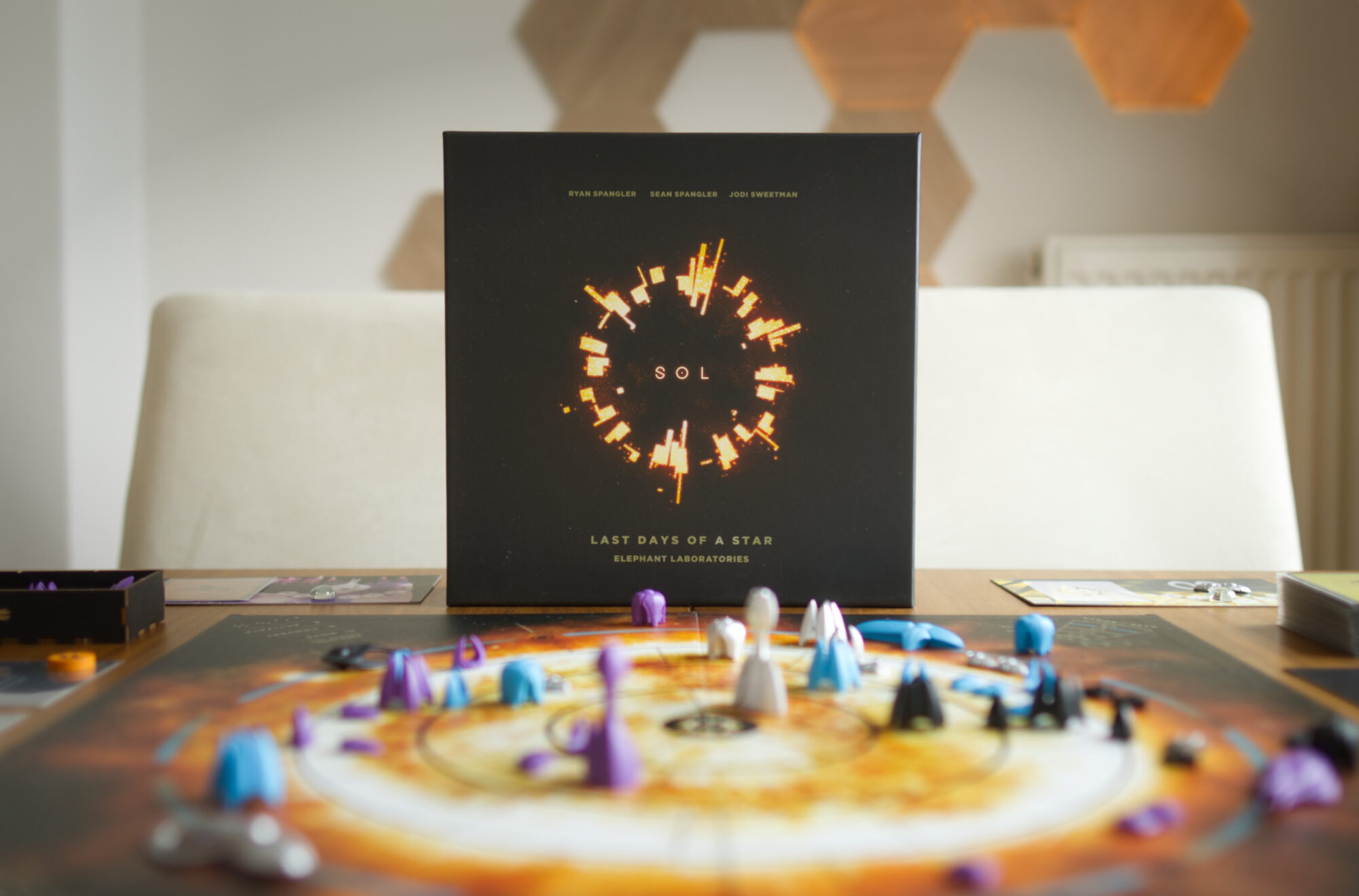Sometimes it’s funny why you end up buying one particular game over the many, many others that are out there. I discovered the classic Grand Austria Hotel for no other reason than it was on sale at a bookstore and I thought “never heard of it, but it’s Lookout Games, let’s give it a try”. Boy, what a pleasant surprise that one was! I grabbed the—to me unknown—Suburbia at a flee market just because it was a city builder and had a unique art style. I felt instantly validated when only a few minutes later someone came to me and asked where I had found it. They had come specifically to the flee market in hopes of finding a copy!
My route to Sol: Last Days of a Star was similarly random. I heard a podcast in which designer Cole Wehrle (Root, John Company, Molly House) told an anecdote of how he had seen it at a convention and was so smitten that he promised to write a review if the designer would allow him to take home the early production copy. I laughed and filed it away, but never had enough of a reason to actually buy a copy myself … but I kept an eye open for one. When I recently spotted a copy on the secondary market, I grabbed it, and boy am I glad I did!
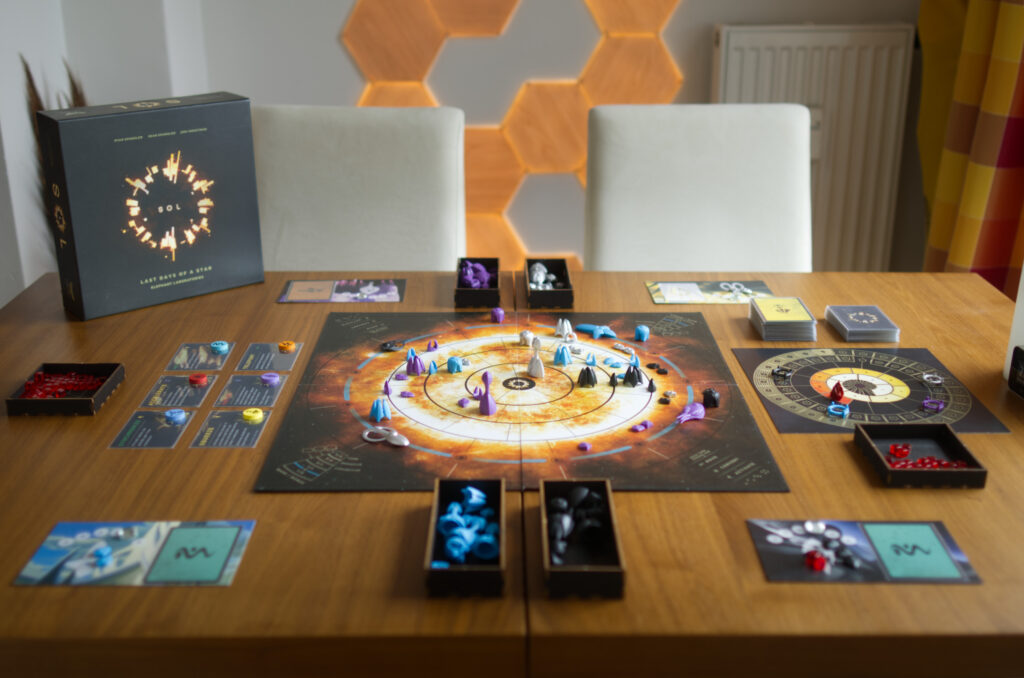
Setup
The production of Sol is a curious one. On the one hand, one is greeted by a set of stunning looking minis, individualised motherships for each of the five player colours (up to the level where the iconography of each of the player aids subtly matches their color’s shape), and a separate booklet about the world Sol plays in. On the other hand, the player aids and victory point board are surprisingly thin, the energy cubes are the cheap looking, Pandemic-style, plastic ones, and the cards … well, let’s just say I have seen prototypes that had better illustrated cards. Overall though, most new players seem to instantly gravitate towards the minis and utter ooohs and aaahs.
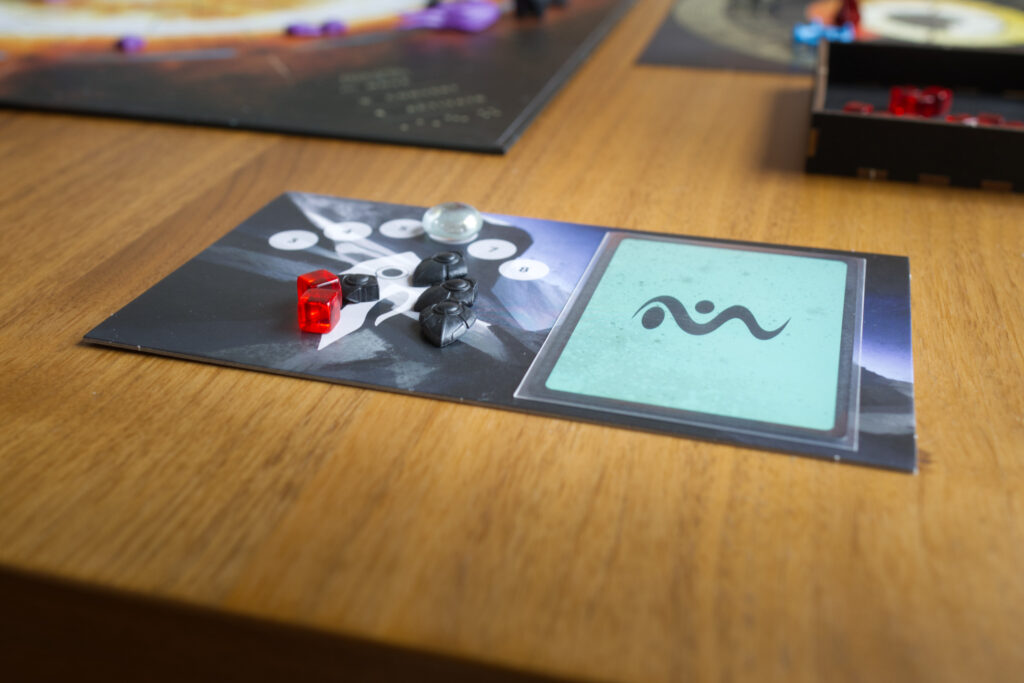
As for setting up the game, each player gets a mothership which will act as launch platform for their worker ships. The motherships are placed in orbit of the sun and will for the rest of the game progress like clockwork on a steady course around it. On their player board, each player puts a—again feeling a bit cheap—glass bead to mark their initial movement as three points per turn, put 8 tiny so called sundivers (the aforementioned worker ships) into the hold of their mother ship (=place them on their player board) and things are almost ready to go.
A deck of more or less solid coloured cards has to be assembled based on player count, e.g. in a three player game four suits of colours are used plus a special “solar flare” suit that is always included. The latter represents the progressing instability of the sun and acts as the game’s timer. One of the distinguishing features of Sol is that each play of it uses a random selection of one-time effects associated with the different coluors of cards in the draw deck. E.g. in one game blue cards may allow a player to teleport a ship anywhere on the board while in another enabling a player to gulp up an opponent’s ship and turn it into two of their own.
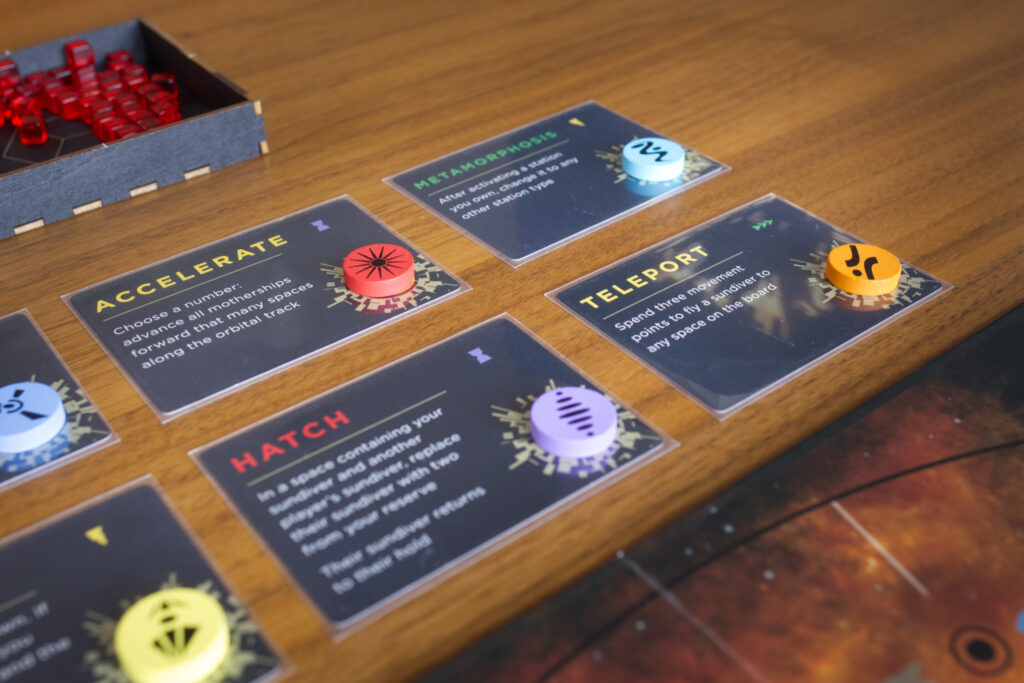
The final step of setup is to place a lovely red fire marker onto the side board that tracks the level of instability of the sun and small ring-shaped minis on the VP track along the outside to track score. So except for assembling the deck and giving it a good shuffle, everything else can be done in a matter of seconds. Note though that the helpful wooden insert shown in the photos was an optional add-on during the Kickstarter campaign.
The Turn
In the world of Sol, each player represents a civilization that until recently has lived in prosperity, thanks to the ability to directly harness the energy of their sun. Unfortunately, this has destabilized said sun and now players race to double-down, grab even more energy and turn it into “movement”(=VP) to fuel their ark ships (those small ring-like shapes), thus escaping a fiery blaze and off to new worlds. Sounds bombastic, but in reality it means moving a tracker up a spiral. In general, Sol feels more like a positional abstract than a particularly thematic game … but one with very nice minis.
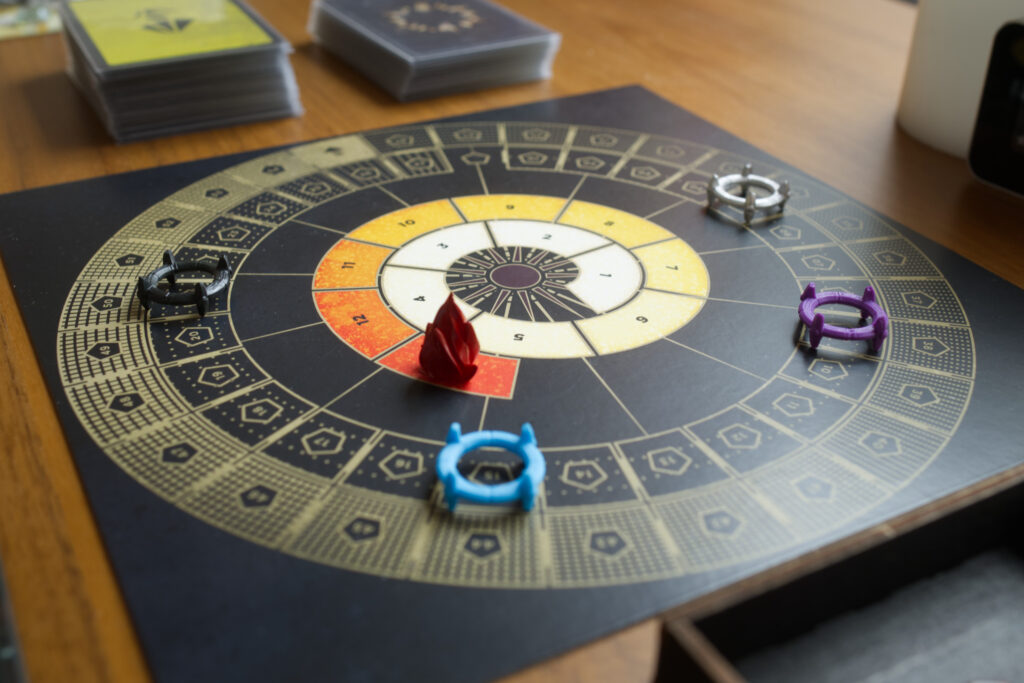
On their turn, the active player can choose to either move their sundiver ships – or – transform them into stations and gates – or — recall ships they have at existing stations to activate them. Each of the individual actions is rather simple and well illustrated on the player aids. If they choose to do one, they can’t do the others until it is their turn again, giving Sol a fast pacing micro-turn sort of feel.
For example, one point of movement allows a player to launch a new sundiver from wherever their mothership currently is, move a sundiver to an adjacent square, or hurl it into the center of the sun and turn it into VP. Note that the three layers of the sun (the three inner rings on the board) are initially inaccessible as they represent diving into the sun itself. During the course of the game, Players can build so called sun gates that can connect layers and allow traveling deeper and deeper.
Building is similarly simple: navigate sundivers into one of the patterns shown on the player aid, destroy the ships (=put back into the supply, not on the player board) and replace them with the building that corresponds to the pattern. Draw cards based on the layer it has been built in and it’s already the next player’s turn.
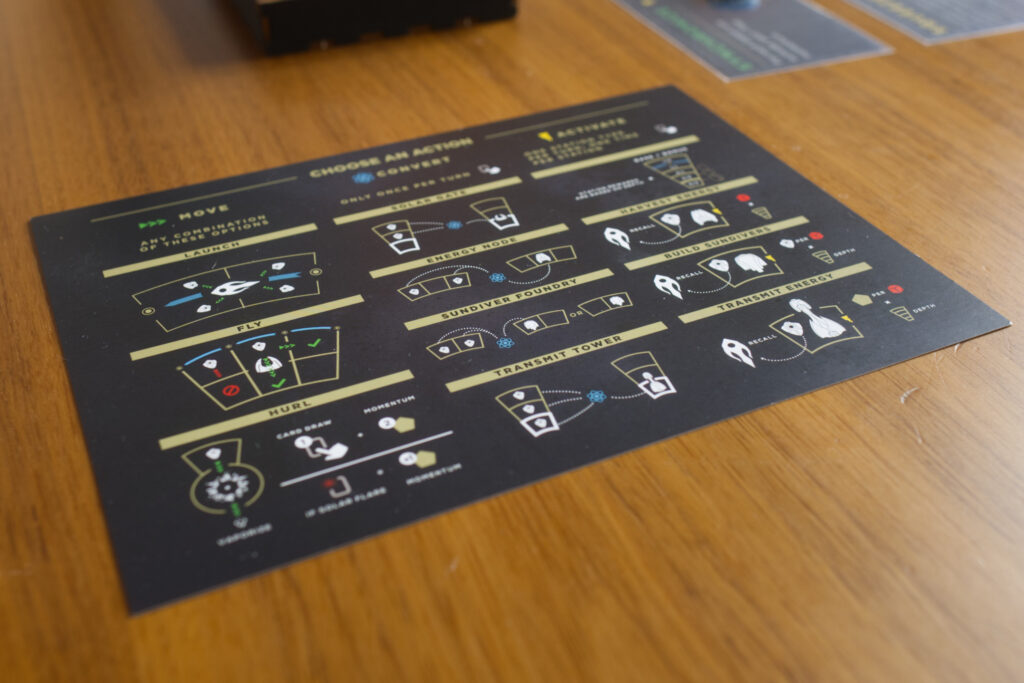
The last option a player has is to activate stations, even those others might have built. They choose a type of station and each one they have a sundiver at can be activated by recalling the sundiver to their player board and back into the belly of their mothership. The economy of Sol is again rather straight forward: energy nodes produce energy (=red cubes), foundries can turn energy into new sundivers, and towers can turn energy into VP. Similar to building, activating allows a player to draw new cards.
The deeper the layer a station is in, the more powerful it is. If a player activates a station owned by another player, that player participates in the activation without having to move any sundivers there themselves but will still have to pay any potential cost in energy.
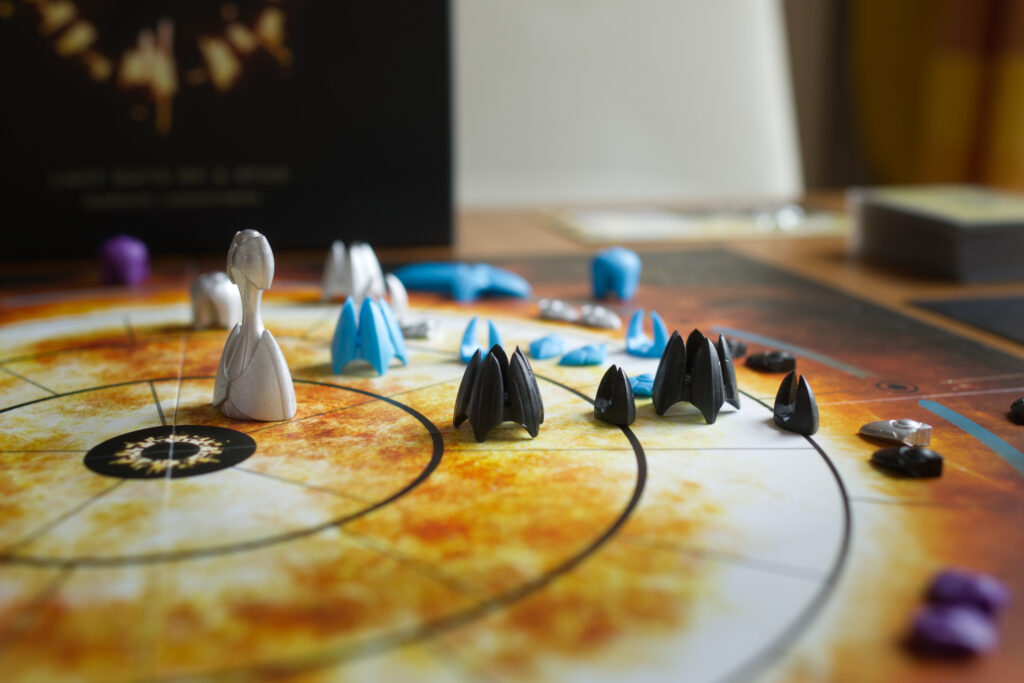
Game End
The game ends as soon as the last solar flare card is revealed. There is no final round or anything like that. The game is immediately over and whoever has accumulated the most VP wins.
Since drawing cards depends on the number of stations that get activated/built and in which layer, a game of Sol keeps accelerating in a sneaky way. Initially, players act mostly outside the sun and spend a lot of time just flying around, both of which let them draw no cards at all. In later turns though, a single player can easily draw six cards in one go! Especially new players thus often fall into the trap of spending too long building up their engine and then running out of time to use it. Make no mistake: Sol is a race! If players know what they are doing, it can be over in less than 45min. For a first play though, 1.5-2h is more realistic as players will take a bit to get more efficient in their movement and start using cards more effectively.
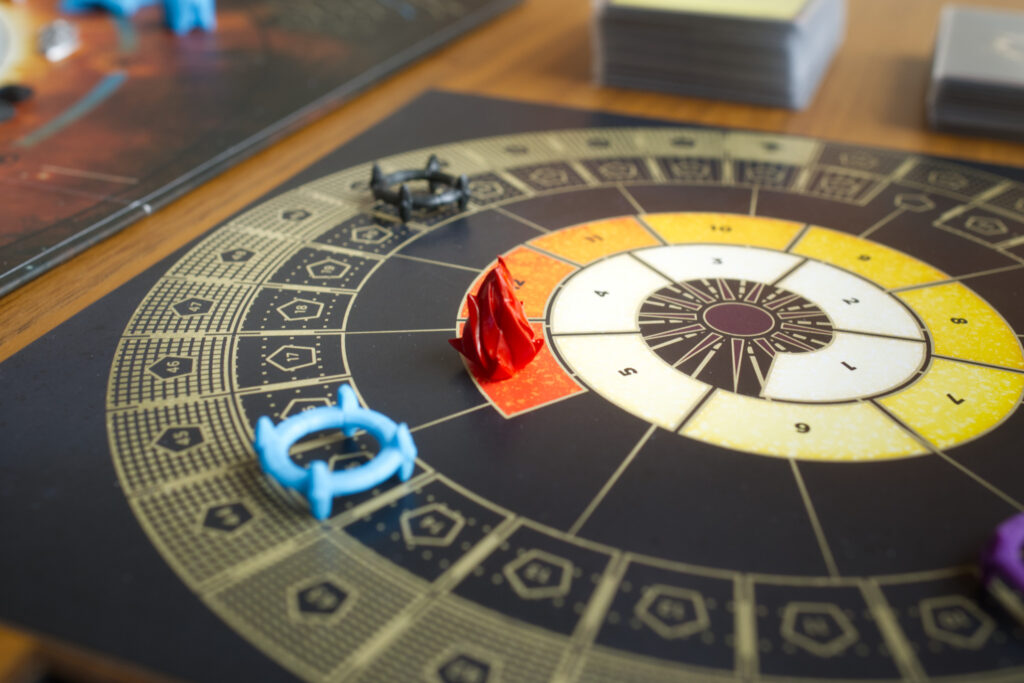
Emergent Gameplay & Dilemma
That’s already it! Except for a few details, you now know how to play Sol. But the shortness of rules belies all the emergent gameplay that they create. Take for example that fact that the mothership is relentlessly moving forward. Since a player can only send out new ships from wherever the mothership is and both building new stations as well as activating them removes ships from the board, timing becomes important. Get it right and your sundivers will miraculously always be close to the action. Get it wrong and you’ll spend a large amount of your turns flying through empty space.
Then there is the dilemma of whether to use enemy stations or not. Using them can reduce the need for flying longer distances and allow for bigger productions at the cost of helping an opponent as well. But again, timing is everything. If one for example activates one of the VP-generating towers when the owner has no energy to turn into VP themselves, the activating player gets to use the owner’s activation bonus in addition to the base activation effect!
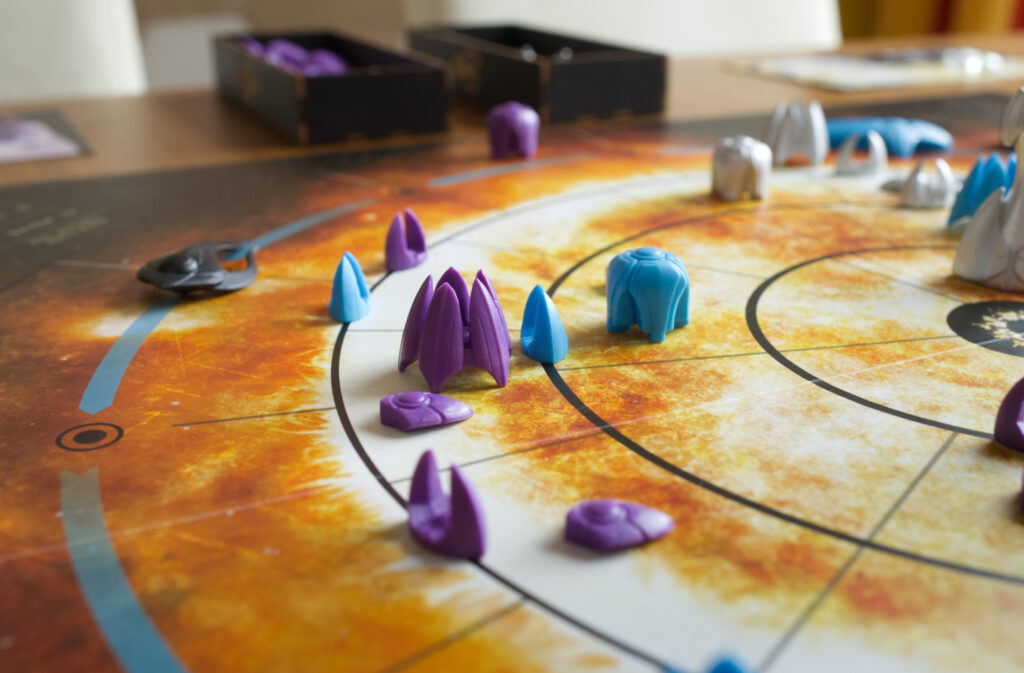
Sol is full of these types of small tweaks. Stations in outer orbit have almost no production capacity at all but activate for free whenever a solar flare card is drawn. Other player’s sun gates can be used but cost energy to do so. Movement is increased when building stations in new layers, further encouraging players to dive deeper and deeper, and so on. The result is that Sol is a game of opportunities, creating them (e.g. incentivizing others to use one’s own stations) and using them. For example, one needs to have a few things set up ready to activate when the mothership is traveling on the “wrong side” of the sun, far away from one’s own stations. Much better to spent turns on activating or converting something than to launch sundivers in places where they won’t be immediately useful.
Key to Sol is utilizing the special card effects on offer. While one isn’t forced to use them, not doing so will inevitably lead to inefficiencies and other players simply being faster in accumulating points. For example, if there is a card effect that temporarily allows a player to—for free—double the ships they can produce at foundries, doing so and then hurling them into the sun will be much faster then first having to fly ships to energy nodes, recall them to generate energy, send the ships out again to towers, then activate those and finally generate some VP. If such a card isn’t in play, hurling ships into the sun will decimate one’s fleet way too fast and doing efficient activations of stations (which don’t destroy ships) will be the better course.
Again, Sol adds an interesting twist: a player can only keep a single card. So they will quickly want to do something that will give them a card (remember: building in orbit around the sun doesn’t give players any cards) and use them in a way that they will be able to do something after it that can give them new cards.
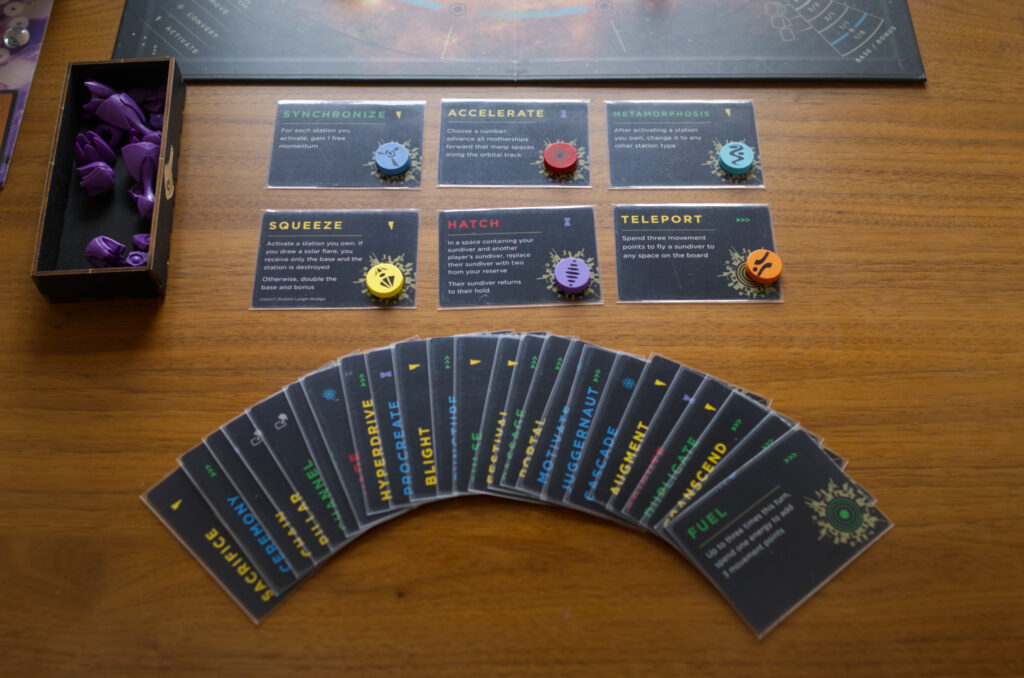
Solo Mode & Player Count
A nice way to illustrate the impact of the card effects is a series of solo challenges that are part of the rulebook. In them, the player will face particular limitations and effects that will force them to explore new approaches to achieve the necessary VP before time runs out. Unfortunately, there is no automa to experience the full multiplayer experience, but I found those puzzles enjoyable nonetheless. Since their number is limited though, I can’t really recommend Sol as a pure solo experience.
So what about the other player counts? In a two player game, having the mothership circle around the sun and waiting for it to return to one’s own infrastructure feels like an eternity. It’s a dry spell where you don’t want to waste your turns on moving long distances. In a four player game, it’s all about big turns and doing activations that trigger multiple stations all at the same time. The sweet spot for me seems to be at 3 players with 2p being my second favorite constellation. At four, there are just too many different card effects in play where in the lower player counts one can better hone in on using the same card effect over and over again. Technically, one could play with more suits of cards but still fewer effects though.
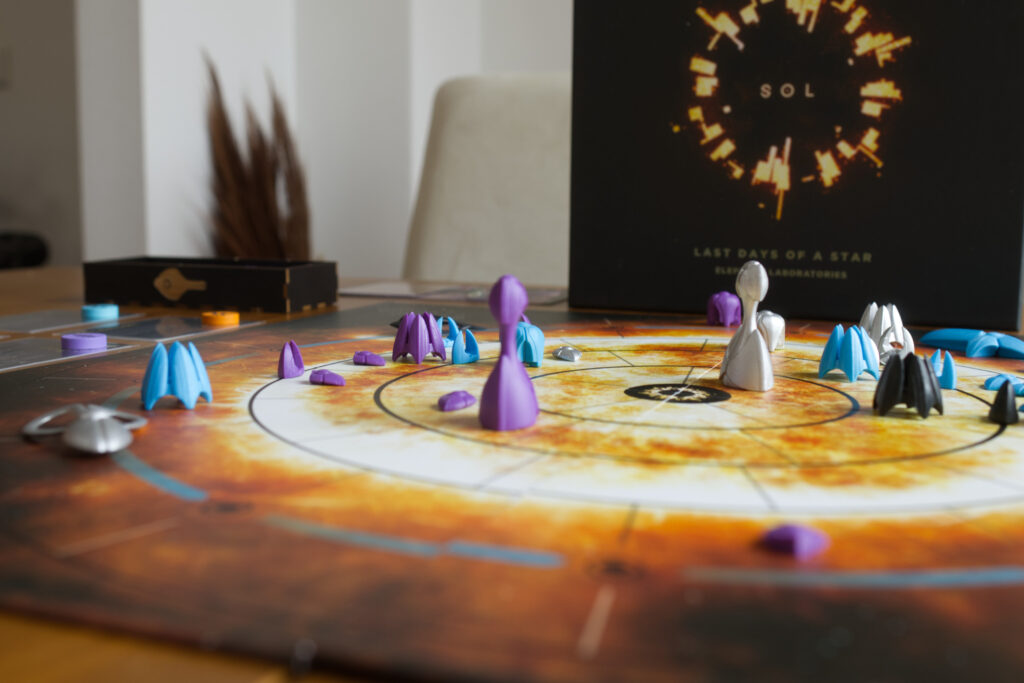
Events & Variants
An additional element that can be used to spice up the core experience is to add one of the included event cards and insert 1-5 trigger cards into the deck. These range from things like free energy suddenly appearing on the board which can be picked up by flying through it up to monsters coming out of the sun’s core and destroying stations.
There are also a set of variants to make the game longer or give players some initial stations for a faster game. I haven’t tried any of those but it’s nice that the designers tried to get as much out of a simple core ruleset as one reasonably can.
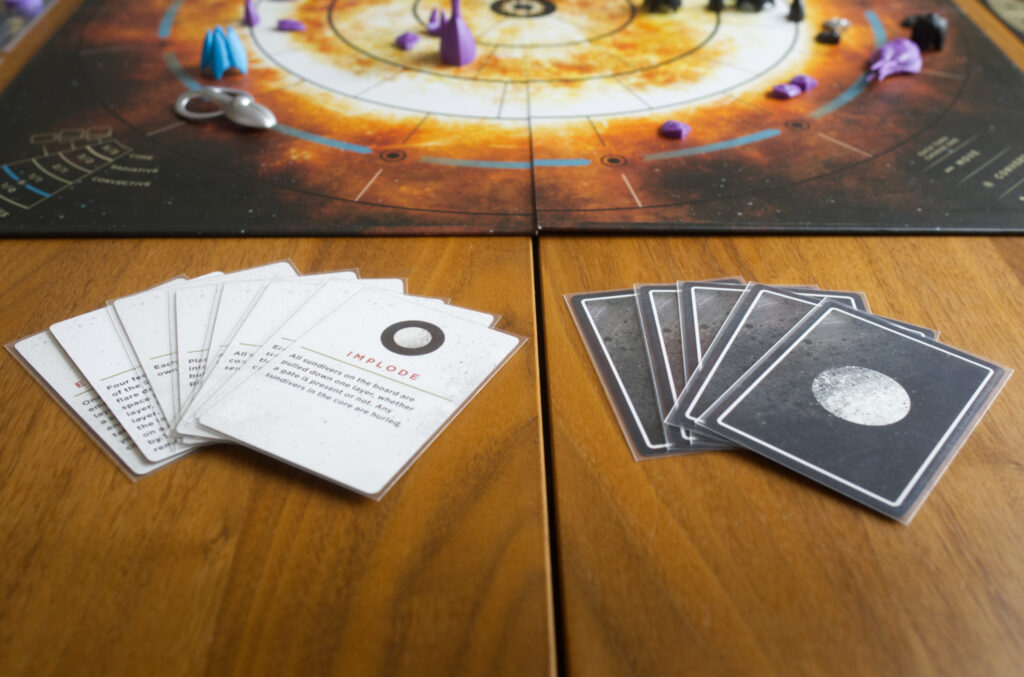
Conclusion
Okay, let’s not beat around the bush: Sol has been one of the most pleasant surprises in board gaming I had so far this year. Reading the description above, you might be wondering why? How can a game so simple create such a good experience? And does that mean the same will be true for you?
Above giant luxurious Kickstarter productions and tons of complexity, one of the things I value most in games is this quality where you play a game and instantly think “we have to play THAT again!”. Sol’s rules get out of the way quickly and after a few turns of just trying stuff and realising how much of a difference a few simple changes in timing can make, players start to think more about the board state and card effects than what the rules are.
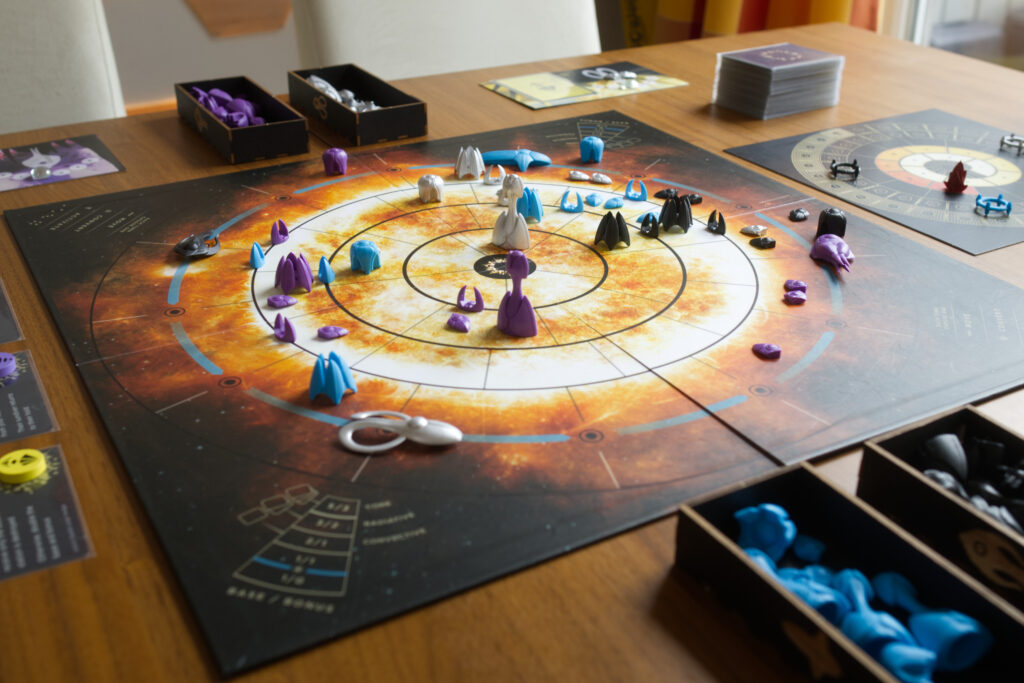
More casual players seem to initially struggle a bit in figuring out how to get their engine running, so much so that I would have wished for the game to come with some form of handicap system. The more experience players get, the more they can (based on the card effects) pick a strategy before the first move is even made and then execute on it. It reminded me a bit of Kingdom Builder or other games with variable scoring conditions where “reading the game” after setup is key. Here though, it’s not the scoring, it’s which effects will most likely get you to accumulate VP faster.
Another point in favour of Sol is its dynamic nature. It’s rather rare that one player directly blocks another player or takes something away from them, but everybody is paying attention what the other players are doing. Is someone running low on energy and it’s the right time to trigger their building without helping them? Is someone building new solar gates that might enable building a station on a deeper layer? Where is that other player flying to …?
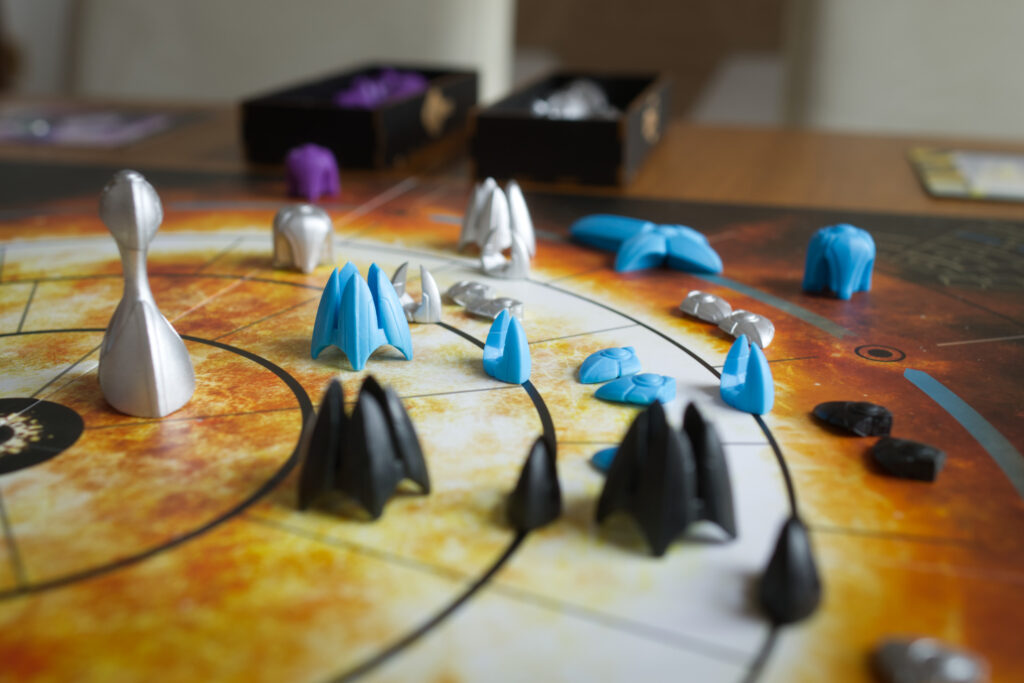
Compact rules, replayability, nice minis, enjoyable at all player counts, reasonable playtime. Looking at it in these terms, it’s easy to see why Sol: Last Days of a Star can be quite attractive. But that omits that there are parts of the production that feel like a Kickstarter project that didn’t quite hit all the stretch goals it had planned to … or a first attempt for a small independent publisher. Having more-pleasant-to-look-at cards would already have done a lot to raise the overall perception. But there are also weird things such as the more frequently used 1-4p side of the map being on the backside of the board where the fold-over is or the strangely thin side-board. I’m also thinking whether I should get some replacement for those “energy” cubes, they feel like the polar opposite of premium. The biggest “issue” I found was that the colour used on the effect card titles to indicate their difficulty/complexity (blue for easy ones, red for cards with a take-that element) often misled players into thinking that’s the colour of card they have to play to active the effect. It would have been better to rather have some subtle dots or stars for a difficulty rating like in Dune Imperium.
Game-wise though I’m very happy with Sol as is. Having only three types of stations seems very limiting at first but it just puts all the more emphasis on the card effects and player interaction. The rules are clear, the rulebook is well written and nicely illustrated. The amount of variants and add-ons like the special events show how much this game was a passion project. The minis are not quite Voidfall-level but still gorgeous, more in a pastel colour abstract kind of way. It’s noticeably though that whenever I try to take a good looking photo that’s not showing the main board, things fall apart.
Part of me wonders why Sol hasn’t been a bigger smash when it came out. The best answer I can come up with is a mixture of not having Mindclash’s marketing budget plus its looks already signalling it being rather abstract tactical than efficiency Euro or thematic space battle. I think there could have been a version of Sol that keeps the same excellent gameplay but just by changes to the presentation would have felt way more thematic. Maybe I should try to paint or at least shade those minis. The current color scheme does have a Through the Desert kind of vibe.
To sum it up, Sol: Last Days of a Star is a keeper for me and one of the few games I will wholeheartedly recommend for the reader to seek out and try. It’s lots of fun without the downsides of much lighter or much heavier/bigger/complex games. It’s a “well, we could always play Sol” kind of game that’s a sure bet for having a good time. It will be a bit too abstract and/or reduced for the liking of many players but reward those that are up for repeated plays. Sol is also a good benchmark: I’m currently thinking about further slimming down my already quite well curated collection. And Sol is the kind of game I want to have in it: one I feel confident I’ll still enjoy playing many years down the line …
